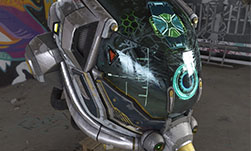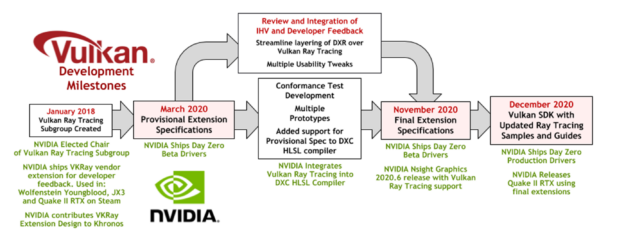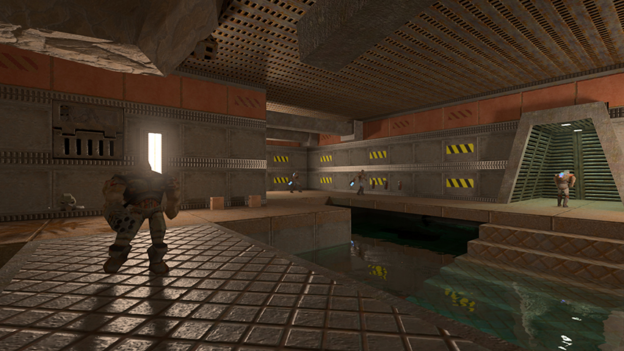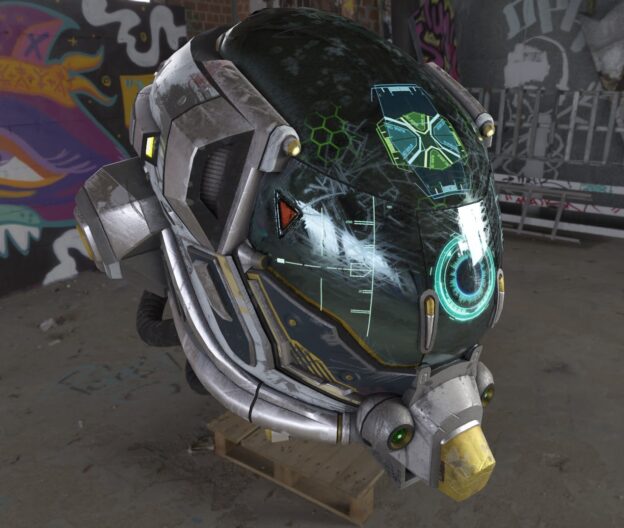 Continuing its industry-leading leading support for Vulkan Ray Tracing, NVIDIA is today rolling out production Vulkan drivers bringing Vulkan Ray Tracing support to GeForce and Quadro for both Windows (version 460.89) and Linux (version 460.27.04).
Continuing its industry-leading leading support for Vulkan Ray Tracing, NVIDIA is today rolling out production Vulkan drivers bringing Vulkan Ray Tracing support to GeForce and Quadro for both Windows (version 460.89) and Linux (version 460.27.04). 
Vulkan is the industry’s first open, cross-vendor standard ray tracing API, enabling portable ray tracing acceleration across diverse platforms.
In November 2020, The Khronos Group released the final versions of the Vulkan Ray Tracing extension specifications that seamlessly integrate ray tracing into the existing Vulkan framework so that developers can reach more platforms and customers with less development and porting costs. Today, Khronos released an upgraded version of the Vulkan SDK with full Vulkan Ray Tracing support, enabling Vulkan developers to easily integrate ray tracing functionality into their applications for the first time.
Continuing its industry-leading support for Vulkan Ray Tracing, NVIDIA is today rolling out production Vulkan drivers bringing Vulkan Ray Tracing support to GeForce and Quadro for both Windows (version 460.89) and Linux (version 460.27.04). All RTX GPUs are supported, together with GeForce GTX 1660 with 6GB+ of memory and GeForce GTX 1060+ with 6GB+ of memory. Together with the support for Vulkan Ray tracing in the NVIDIA Nsight Systems 2020.5 and Nsight Graphics 2020.6 developer tools, all developers are now enabled to integrate portable ray tracing into software ranging from real-time games to professional applications.

Bringing ray tracing functionality into the Vulkan standard has been a multi-year effort by many companies and NVIDIA has taken an active leadership position in each stage of its evolution. We were elected to chair the Vulkan Ray Tracing subgroup at Khronos, we contributed the design of our VKRay vendor extension to Khronos to help the Vulkan working group make rapid progress, and we shipped beta drivers for the provisional version of the Vulkan Ray Tracing extensions to enable developer feedback.
NVIDIA has also implemented Vulkan Ray Tracing support in Microsoft’s open source DXC HLSL compiler. As outlined earlier this year, production-ready use of HLSL in Vulkan has been achieved through integrating a SPIR-V backend into DXC. Now, NVIDIA has extended that SPIR-V support to include Vukan Ray Tracing functionality, enabling developers to use HLSL shaders in Vulkan Ray Tracing applications instead of GLSL if they prefer. This also makes porting DirectX 12 ray tracing (DXR) functionality to Vulkan far easier to enable applications on a far wider diversity of platforms.
Vulkan is used extensively as a backend for layered implementations of APIs such as DirectX 12 to enable Windows games on platforms such as Linux. Vulkan Ray Tracing has been carefully designed to support the efficient layering of DirectX 12 ray tracing to enable tools such as Valve’s vkd3d-Proton to support the execution of applications that use DXR on Linux. NVIDIA is actively contributing to the development of translation tools such as Wine, whose upcoming 6.0 release supports Vulkan specification version 1.2.162 which includes Vulkan Ray Tracing.

In 2019, NVIDIA worked to bring ray tracing to Quake II. The Quake II RTX demo significantly enhances the visual quality of this well-loved classic running on Vulkan with ray-traced lighting, shadows, and reflections. NVIDIA released the full source code on GitHub serving as a great example for developers who want to dive into the details of how this remastering was achieved. Today, with the release of Quake II RTX 1.4.0, NVIDIA has added support for the final Vulkan Ray Tracing extensions, enabling dynamic selection between the pre-existing NVIDIA VKRay and the new Khronos extension backends. This means the game can now run on GPUs from any vendors that support the `VK_KHR_ray_tracing_pipeline` extension, making Quake II RTX the world’s first cross-vendor ray tracing Vulkan game!
To learn more about Vulkan Ray Tracing and how you can use it in your own applications check out Khronos-hosted resources including: how to use the Vulkan Ray Tracing extensions, a deeper dive into the technical details of the final Vulkan Ray Tracing specifications and best practices for blending Vulkan rasterization and ray tracing techniques. The Khronos Group is actively monitoring developer feedback on the Vulkan Ray Tracing extension through the Vulkan issues tracker on GitHub.

NVIDIA has also created a deep dive Vulkan Ray Tracing Tutorial, and a new tutorial that steps through how to create a complete mini-path tracer using the Vulkan Ray Tracing API, and a Vulkan-based glTF ray tracing viewer with open source on GitHub. Keep up to date with NVIDIA’s ongoing support for Vulkan on the NVIDIA Vulkan Developer Page.
Vulkan Ray Tracing is a critical step to making ray tracing pervasive across the computer graphics ecosystem, and it is now easily accessible to developers everywhere.
We can’t wait to see how you use it!
